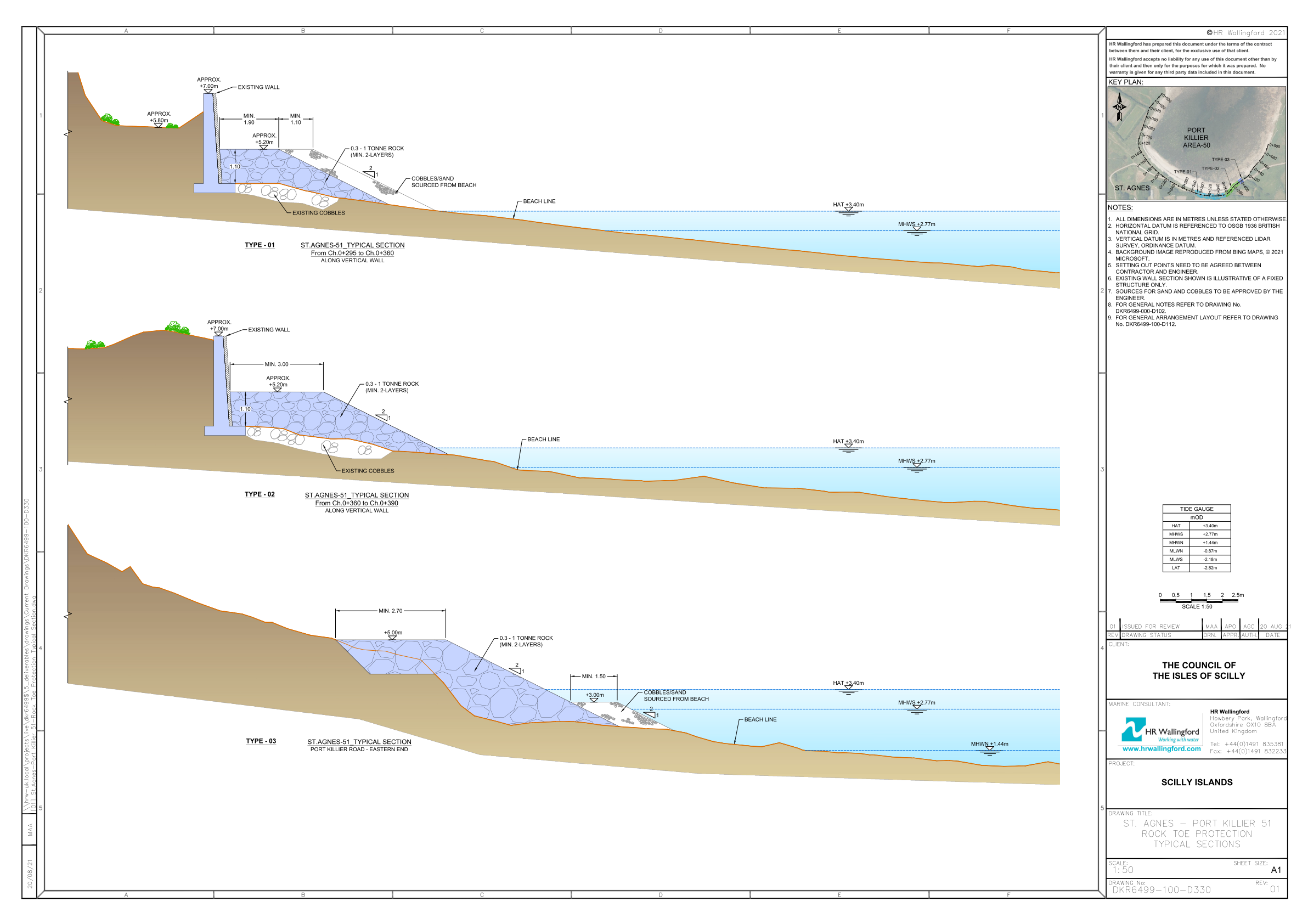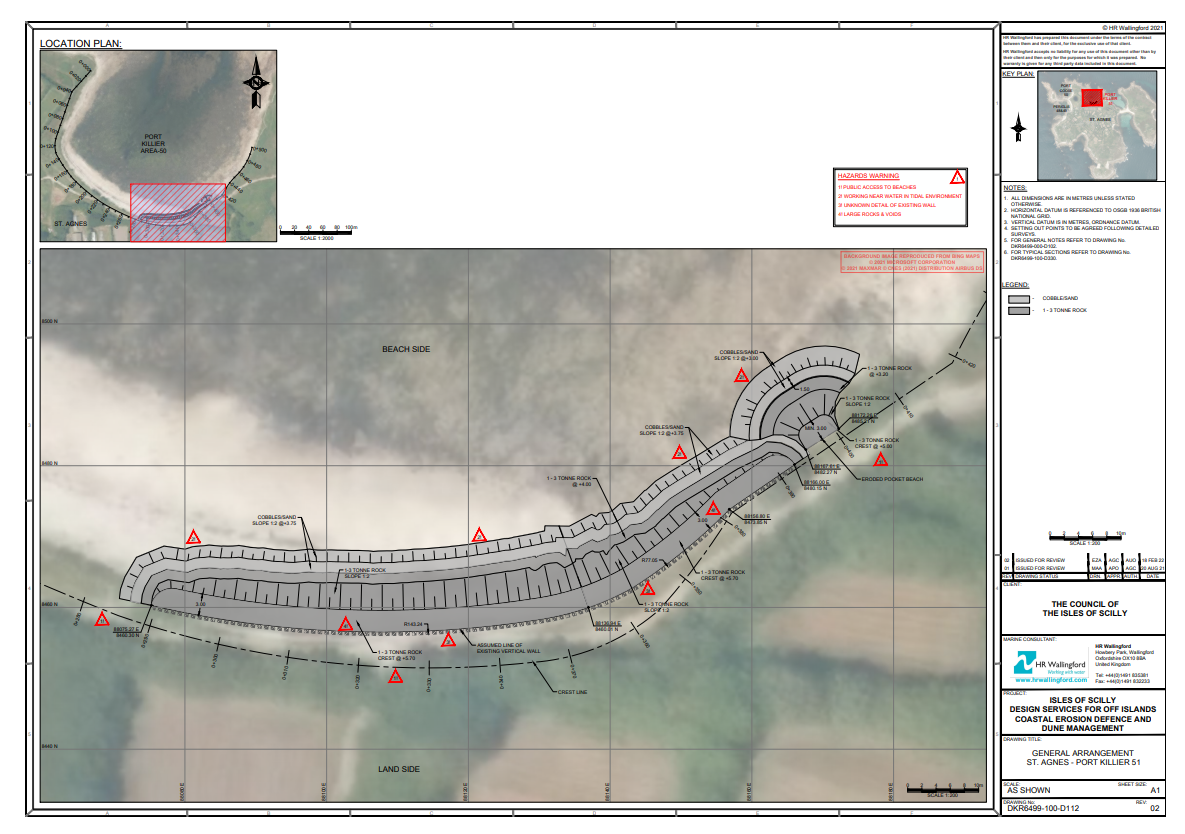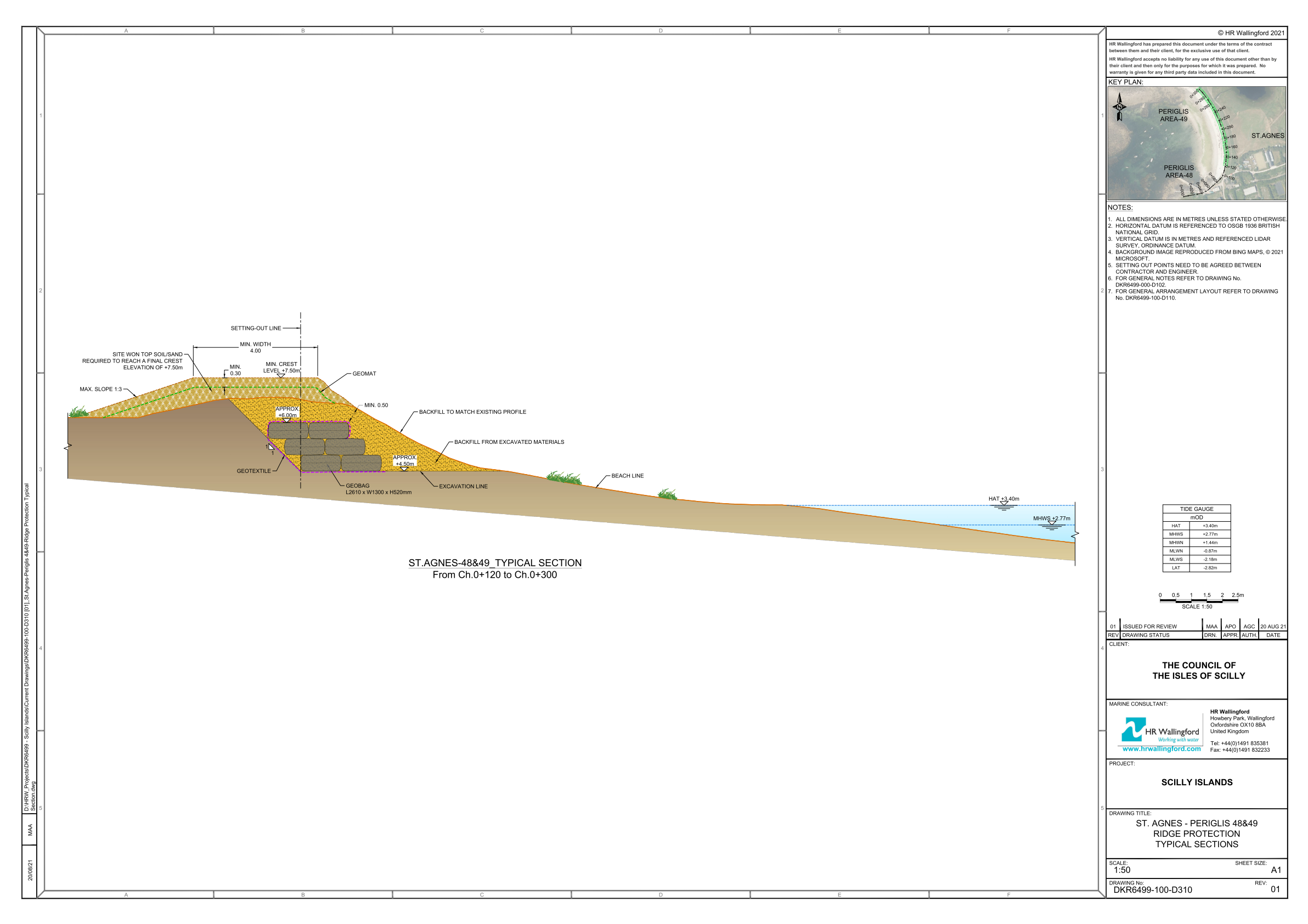There are three sea defence proposals for St Agnes and details for each of these are included below. You can also download images of the design proposals on the right hand side. These include a top down image and a cross section of the proposed work. Shortcuts to each individual site and a summary of the feedback received on the designs are below:
Porth Killier
What’s the problem?
Porth Killier has 2 areas where work is proposed, the seawall and a small area of rock armour to the east of the existing seawall. Along the seawall there is significant erosion at the toe of the wall. The wall could be undermined and fail. A small rocky beach east of the seawall has localised ram erosion. Here this risks the road being undercut, as well as waves overtopping the road and flowing into the fields behind.
What’s the suggested solution?
To protect the stability of the wall, rock armour will be installed along part of its length. At the western end of this, cobbles and sand from the beach will be added to blend the work into the beach. At the eastern end, where the most damage is, rock armour will provide additional protection. Along the wall the rock armour will rise to approximately 1.1 m and extend 3 m from the existing seawall towards the sea. To protect the ram from erosion at the eastern end, a rock armour revetment is proposed. The rock would be placed up to the crest of the underside of the ram in order to reduce the cutback occurring towards the road. This would extend the width of the crest by a minimum of 2.7 m and the bottom of the rock armour would be covered using cobbles and sand sourced from the beach.


Porth Coose
What’s the problem?
Porth Coose suffered severe overtopping during the 2013-14 winter storms, weakening the protection provided by the sea defences here. The crest and rear side were breached, and this has lowered the height of the sea defences, effectively exposing Big Pool to seawater inundation.
What’s the suggested solution?
The proposal at Porth Coose is to raise the height of the crest by using geobags. These are typically large mesh bags filled with smaller rocks. Placing these along the length of Porth Coose would raise the crest height by approximately 1.2 m and widen it by 2.4 m. There is an existing concrete mattress on the seaward side which would be left in place. The landward side of the mesh bags would be covered with site won material including sand and cobbles, to slope down from the crest to the existing ground. This would be reseeded to help re-establish the habitat and to fix the topsoil to protect the rear of the crest from any erosion.


Periglis
What’s the problem?
The crest along Periglis has seen significant erosion since 2013-14. The crest has lowered at the north and centre of the bay, and the dune has retreated at the southern end. All of this creates a risk for overtopping and flood water running into Big Pool. Bulk bags have been positioned in parts of dune which has helped to strengthen the bank and supported the natural increase in sand found on the beach.
What’s the suggested solution?
Taking inspiration from the works that were carried out previously, the proposals suggest using an enhanced core, covered with recovered materials. This would work by excavating part of the existing bank and placing geobags at the core. The bags would be covered by a mix of sand and cobbles, topped up by locally excavated materials where available. The crest height would be increased with site won topsoil and widened to a minimum of 4 m. The bank would be planted with local vegetation to provide additional strength and to blend in with the local habitat.


Feedback
Thank you to everyone who submitted feedback on the proposals for St Agnes. The responses have all been helpful and will inform the designs and our planning application. There were a range of questions submitted and we have summarised these, providing answers below.
Is the rock armour proposed at Porth Killier of sufficient size? It looks too small.
The specification for the rock sizes has been increased to 1-3 tonne rocks following feedback from residents and contractors.
Can the toe of the wall at Porth Killier be repaired with concrete reinforcement in a way that can be repaired locally in the future?
The preferred design is to provide a more permanent fix using rocks that can dissipate wave energy effectively, to avoid continual maintenance of the existing concrete reinforcement and the risk that maintenance following one storm cannot be completed before a second storm strikes. Some local repair may be required before the rock armour is emplaced.
Is the existing concrete mattress going to last? And are there plans to repair this? Can a method for repair of existing armour belting be developed?
Council inspects the condition of all coastal assets regularly. The existing armour belting is nearing the end of its design life, but the designers noted that it largely still is intact. There are a few places on the armour belting where it is showing signs of separating. Repair of armour belting will be part of the ongoing maintenance required for all coastal assets, to be delivered under a separate project to Climate Adaptation Scilly. The methods used for repair of armour belting are to be developed.
Can you really get the amount of ‘site won material’ that is proposed in the plans for Porth Coose and for Periglis?
The amount of ‘site won material’ identified in the designs was assessed by a professional Quantity Surveyor. There will still need to be material imported to the island to make up the balance of material required for the works.
Why aren’t the rock bags anchored to the bank?
The mass of the rock bags, the concrete mattress in front protecting their toes, and the support from the backfill material behind means they are unlikely to move during the storms. Anchors were deemed by the designers to be unnecessary. The designers also noted that the material used for the rock bags resist rock strikes and UV degradation. If the backfill material behind is removed by high seas, it will be repaired with the spare materials provided.
Will the defences at Periglis just get exposed when there’s a big storm?
The bags will be placed much deeper into the dune compared to the previous reinforcement works which should help when it comes to exposure. Due to the severity of storms that we get, some repair work in the future may be needed. We will keep a store of repair materials (sand, cobbles, shingle etc) on St Agnes and we will have a contract with someone who will be in charge of repairing sections of the dune that might become more severely eroded
What material will the geobags be made from?
The bags are made from plastic but are designed to work in a sea defence setting. The mesh design means they will move with the dune which should mean their performance won’t degrade significantly over time. Unfortunately, natural materials are unlikely to perform as well, especially as these proposals aim to protect Periglis for the next 25 years as a minimum.
Is it possible to use 6 tonne plus rocks in a line at the toe of both Perigilis and Porth Coose?
Discussion with the engineering designers suggests rocks in this position will lead to scour of materials from behind the rocks through the gaps that will exist. They may also lead to scour of the beach in front of the rocks, because they offer a solid surface against which the waves can reflect.
Where will you be unloading materials? We would recommend landing on Periglis.
Unloading of materials will take place at Porth Conger onto the beach in front of the pub, or on the quay, from which materials will be moved to the forward working site behind the resource recovery area at Porth Conger. While it is possible to use Periglis for unloading, it would probably require boats to be moved from their moorings over the warmer part of the year, and in winter it is more likely that Periglis would be difficult to access during storms.
The storms and swell heights of 2014 suggest that even if the bank heights are raised by the proposed amounts it will not prevent overtopping.
The design heights are based on coastal flood modelling undertaken in 2019. Sea defences that prevent all overtopping are extremely expensive and would have to be very high on the Isles of Scilly. The proposed works will limit overtopping volumes for a period of 25 years, while the islands plan how to respond to continually rising sea levels.
If you have any further questions about the proposals for St Agnes please get in touch at adaptivescilly@scilly.gov.uk
Protection of Your Personal Information
The Council of the Isles of Scilly will use the personal information you provide to help it understand and respond to your feedback. By sending in an email to us in response to these site proposals you are agreeing for your information to be used in this way.
The personal information you provide will be used only to respond to your feedback and will not be shared with any other part of the Council or other organisations. The personal information will also be stored by the Council until the end of the project in July 2023, then deleted from the Council’s systems.
You can request access to a copy of your information held by the Climate Adaptation Scilly project, or removal of the information held, by email to adaptivescilly@scilly.gov.uk, by letter to Climate Adaptation Scilly, Unit 7, Porthmellon Enterprise Centre, Hugh Town, St Mary’s, TR21 0JY or by telephone to 07871 982 620
| Attachment | Size |
|---|---|
| 1.28 MB | |
| 1020.28 KB | |
| 1009.3 KB | |
| 765.21 KB | |
| 1.05 MB | |
| 823.7 KB |

